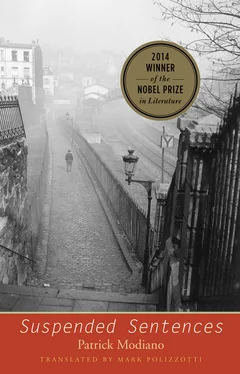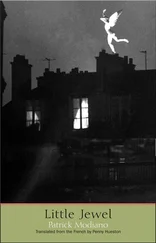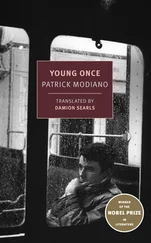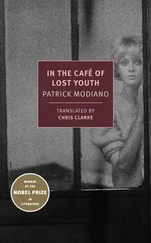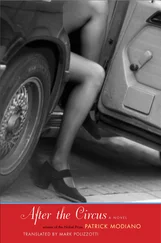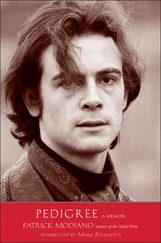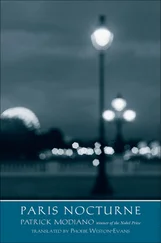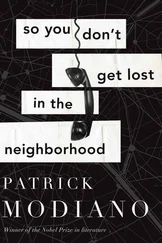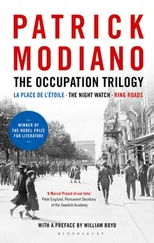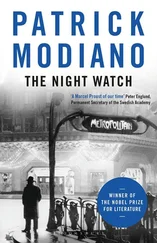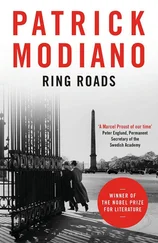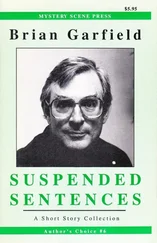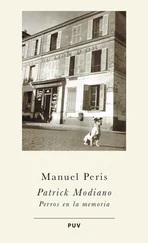The radio? So you could listen to the radio in this car? He pushed an ivory button on the dashboard, and instantly we heard music.
“Should I turn it up or down, boys?” he asked us.
We didn’t dare answer. We listened to the music coming from the dashboard. And then a woman started singing in a raspy voice.
“That’s Edith singing, boys,” said Roger Vincent. “She’s a friend …”
He asked Little Hélène:
“Do you still see Edith?”
“Now and then,” said Little Hélène.
We drove down a large avenue and arrived in Versailles. The car stopped at a red light, and we admired, on a lawn to our left, a clock whose numbers were made of flowerbeds.
“The next time,” Little Hélène said to us, “I’ll take you to see the palace.”
She asked Roger Vincent to stop at a store where they sold used furniture.
“Boys, you stay here in the car,” said Roger Vincent. “Watch the car for me …”
We were proud to be entrusted with such an important mission and we watched the comings and goings of the passers-by like hawks. Behind the window of the store, Roger Vincent and Little Hélène were talking with a dark-haired man wearing a raincoat and a mustache. They spoke for a very long time. They had forgotten about us.
They came out of the store. Roger Vincent was holding a leather suitcase that he stashed in the trunk. He got back behind the wheel, with Little Hélène next to him. He turned back toward me:
“Anything to report?”
“No … Nothing …” I said.
“So much the better,” said Roger Vincent.
On the way back, in Versailles, we followed an avenue at the end of which rose a brick church. Several fairground stalls occupied the median strip, around a glittering bumper car track. Roger Vincent parked along the curb.
“Shall we take them for a ride in the bumper cars?” he asked Little Hélène.
The four of us waited at the side of the track. Music blared very loud through speakers. Only three cars were being used by customers, two of which chased the third and rammed it at the same time, on either side, producing screams and shouts of laughter. The trolley poles left trails of sparks along the ceiling of the track. But what captivated me more than anything was the color of the cars: turquoise, pale green, yellow, purple, bright red, mauve, pink, midnight blue … They stopped moving and their occupants left the track. My brother climbed into a yellow car with Roger Vincent, and I, with Little Hélène, into a turquoise one.
We were the only ones on the track, and we didn’t ram each other. Roger Vincent and Little Hélène drove. We circled the track, and Little Hélène and I followed Roger Vincent and my brother’s car. We zigzagged among the other cars, empty and motionless. The music played less loudly, and the man who had sold us our tickets looked forlorn, standing at the side of the track as if we were the last customers ever.
It was nearly dark. We stopped at the edge of the track. I looked one more time at all those cars with their bright colors. We talked about it, my brother and I, in our room after lights out. We had decided to build a track in the courtyard the next day, with old planks from the storage shed. Naturally, it wouldn’t be easy to get hold of a bumper car, but maybe you could find old ones that didn’t work. It was mainly the color that interested us: I couldn’t decide between mauve and turquoise; my brother had a predilection for very pale green.
The air was warm and Roger Vincent hadn’t put down the top of his convertible. He was talking with Little Hélène, and I was thinking too much about those bumper cars we’d just discovered to listen to their grown-up conversation. We drove past the airfield and would soon turn left onto the road that went up to the village. They raised their voices. They weren’t arguing, just talking about Andrée K.
“Sure she was,” said Roger Vincent. “Andrée was part of the Rue Lauriston gang …”
“Andrée was part of the Rue Lauriston gang.” That sentence had struck me. In school, we, too, had a gang: the florist’s son, the barber’s son, and two or three others I don’t remember, who all lived on the same street. They called us “the Rue du Docteur-Dordaine gang.” Andrée K. had been part of a gang, like us, but on a different street. That woman who so intimidated my brother and me, with her bangs, her freckles, her green eyes, her cigarettes and mysterious phone calls, now suddenly seemed more like us. Roger Vincent and Little Hélène also seemed to be very familiar with that “Rue Lauriston gang.” Subsequently, I again overheard the name in their conversation and I became used to the sound of it. A few years later, I heard it in the mouth of my father, but I didn’t know that “the Rue Lauriston gang” would haunt me for such a long time.
When we arrived back on Rue du Docteur-Dordaine, Annie’s 4CV was there. Behind it was a huge motorcycle. In the vestibule, Jean D. told us the motorcycle was his and that he’d come to the house on it all the way from Paris. He hadn’t removed his Canadienne. He promised to take us for a ride on the motorcycle, by turns, but tonight it was too late. Snow White would be back the next morning. Mathilde had already gone to bed, and Annie asked us to go up to our room for a bit because they needed to talk. Roger Vincent went into the living room, leather suitcase in hand. Little Hélène, Annie, and Jean D. followed him in, and they closed the door behind them. I had watched them from the top of the stairs. What could they be saying to each other, there in the living room? I heard the telephone ring.
After a while, Annie called us. We all ate dinner together at the dining room table: Annie, Little Hélène, Jean D., Roger Vincent, and the two of us. That evening, at dinner, we were not wearing our bathrobes, as usual, but rather our daytime clothes. Little Hélène did the cooking because she was a real cordon bleu.
We lived on Rue du Docteur-Dordaine for much more than a year. The seasons follow one another in my memory. In winter, at midnight Mass, we were choirboys in the village church. Annie, Little Hélène, and Mathilde attended Mass. Snow White spent Christmas with her family. When we got back, Roger Vincent was at the house, and he told us someone was waiting in the living room. My brother and I went in and found Santa Claus, sitting on the chair with the flowered upholstery next to the telephone. He didn’t speak. He handed each of us, in silence, presents covered in silver paper. But we didn’t have a chance to unwrap them. He stood up and motioned for us to follow. He and Roger Vincent led us to the glass-paneled door that looked out on the courtyard. On the wooden planks we had laid end to end, there was a bumper car colored pale green — the way my brother liked them. Then we had dinner together. Jean D. showed up to join us. He had the same height and movements as Santa Claus. And the same watch.
Snow on the playground at school. And freezing rains in March. I had discovered that it rained practically every other day and I could predict the weather. I was always right. For the first time in our lives, we went to the movies. With Snow White. It was a Laurel and Hardy film. The apple trees in the garden flowered anew. Once more, I accompanied the Rue du Docteur-Dordaine gang to the mill, whose large wheel was turning again. We began flying kites again, in front of the chateau. We were no longer afraid, my brother and I, of going into the great hall and walking among the rubble and dead leaves. We sat down at the far end, in the elevator, an elevator with two screen doors, made of light paneled wood and with a red leather bench. It had no ceiling and daylight fell from the top of the shaft, through the still intact skylight. We pushed the buttons and pretended to go up to the various floors, where the marquis Eliot Salter de Caussade might have been expecting us.
Читать дальше
